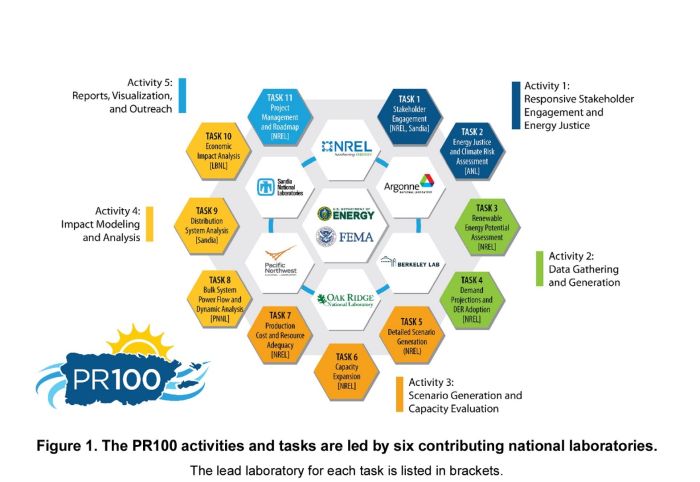Energy Transition, Climate, Turnaround and Restructuring
Case Study: Puerto Rico's Energy Grid Rapid Transition To Renewables
PR100 Summary Report on Puerto Rico's Grid Resilience and Transition
In February 2024, the U.S. Department of Energy (DOE) published its PR100 Summary Report on Puerto Rico's grid resilience and transition to 100% renewable energy by 2050 (PR100 Project or report). DOE led a task force composed of Argonne National Laboratory, Lawrence Berkeley National Laboratory, National Renewable Energy Laboratory, Oak Ridge National Laboratory, Pacific Northwest National Laboratory, and Sandia National Laboratories. The PR100 project was assisted by a broad and multi-disciplinary Advisory Group1, in which Ankura professionals participated.2
The study examines potential pathways for Puerto Rico to achieve its goal of 100% renewable energy by 2050. The findings indicate that the renewable energy resource potential is more than sufficient to meet its projected electricity demand by 2050.
The PR100 Project was catalyzed by the catastrophic effects of hurricanes Irma and Maria in 2017 and the resulting impact and destruction to Puerto Rico's electric grid. The Puerto Rico Electric Power Authority (PREPA) is the largest publicly owned power utility in the U.S. by number of customers served. Well before filing for bankruptcy and the impact of two devastating hurricanes in 2017, PREPA's electric service was of poor quality (e.g., voltage and frequency), and performance metrics like SAIDI3 and SAIFI4 placed PREPA at the bottom of its peers in the industry compared against IEEE5 U.S. median SAIDI/SAIFI benchmarks. Since filing for bankruptcy, PREPA's annual business plans (known as fiscal plans under the Puerto Rico Oversight, Management, & Economic Stability Act (PROMESA)), the government, regulators, and relevant stakeholders have acknowledged the fragile and aged nature of the electric grid. Its isolated nature, exposure to hurricanes and other natural disasters, as well as historically poor management of a vertically integrated utility monopoly, economic challenges, reduced sales, disruptive technologies, and demographic changes – only added to the need and urgency for radical and rapid restructuring and transformation to a more resilient, sustainable, and dependable electric grid for over 3.3 million residents, including 1.4 million residential, commercial, and industrial utility customers.

Source: Puerto Rico Grid Resilience and Transitions to 100% Renewable Energy Study (PR100), dated February 2024, by Argonne National Laboratory (ANL), Lawrence Berkeley National Laboratory (LBNL), National Renewable Energy Laboratory (NREL), Oak Ridge National Laboratory (ORNL), Pacific Northwest National Laboratory (PNNL), and Sandia National Laboratories for the U.S. Department of Energy (DOE).
Policy Underpinnings and Practical Considerations for Energy Transition
- Legal framework for the island's energy transition
to clean energy: The Puerto Rico Energy Public Policy Act,
known as Act 17-2019, set the outside goal of serving 100% of the
island's electricity needs with renewable energy by 2050. To
achieve this, it set a target of 40% renewable energy by 2025, and
60% by 2040. Act 17-2019 also phases out coal-fueled power
generation by 2028. The Public Policy on Energy Diversification by
Means of Sustainable and Alternative Renewable Energy, Act 82-2010,
as amended. Act 82-2010 contemplates energy resource
diversification that includes solar, wind, hydro, marine and
hydrokinetic renewable, ocean thermal, and combustion of biofuel
from renewable biomass.
Thought Insight
The Puerto Rico Energy Bureau (PREB) also authorized the
2020 Integrated Resource Plan (IRP) which
incorporates the Renewable Portfolio Standards (RPS) targets and
dates. The IRP is undergoing a regulatory review and update that
began in late 2023 and will run through 2024.
- Key Drivers of Energy Transition: Unsustainable utility debt, changing load, socioeconomic challenges, volatility of rates (fuel and purchased power prices), the need for dramatic investment in reconstructing and modernizing, environmental compliance, and climate concerns, among others.
PR100 Scope of Work
PR100 Project consisted of multiple phases that included the following:
- Energy justice analysis in addition to traditional varied stakeholder engagement. The energy justice evaluation covered infrastructure interdependency, resilience, and climate risk considering the impacts of sea level rise and other impacts from climate change on the electric grid.
- Data gathering, data generation, and modeling work – to develop views on projected electricity demand over 25 years, electric vehicle (EV) adoption, energy efficiency, and distributed energy resources (DERs).
- Defining certain scenarios6 for an improved understanding of a cost-effective mix of technologies for power delivery, production costs, and resource adequacy. These scenarios assumed that Puerto Rico's grid was substantially reconstructed to support improved reliability.
PR100 Project Findings7
- Renewable Energy Potential: Puerto Rico's technical potential for renewable energy sources like solar and wind far exceeds the projected total annual loads through 2050. The transition to 100% renewable energy is feasible with mature technologies such as solar Photovoltaic(PV) and wind and does not require any technological breakthroughs.
- Electric Load Projections: The study projected a possible decrease in electric load by 2050 due to declines in population and economic forecasts. However, a 'Stress' scenario considers the possibility that loads do not decline, emphasizing the importance of planning for a range of load trajectories.
- Distributed Solar PV and Storage: Rapid adoption of rooftop solar and storage is anticipated to continue due to economic benefits and the desire for backup power. Under all scenarios, significant increases in distributed PV capacity are expected.
- Capacity Expansion: Immediate actions are needed to increase capacity to achieve a robust system. New renewable resources will contribute to near-term renewable energy targets (the report recognizes that Puerto Rico is delayed in deploying renewable power under the current legal framework). E.g., to meet the 40% RPS goal by 2025, the capacity expansion model's optimal solution contemplates several GW of solar and BESS8 with land-based wind.
- Operational Scheduling and System Dynamics: With some pointed reservations about the lower voltage (38-kV) transmission network, the study suggests that with proper scheduling and operational strategies, the projected future systems can manage forecast errors and maintain reliable service.
- Distribution Grid Impacts: Certain feeders in Puerto Rico operate outside the ANSI Range A standard voltages even without PV production. These feeders are assumed to be fixed prior to adding PV system simulation.
- Economic Impacts: The transition to renewable energy is associated with substantial utility-incurred costs (increasing revenue requirements), with the potential for retail rate increases affecting nonadopters of rooftop PV.
- Accounting for solar radiation, cloud coverage, and rainy/storm seasons: The report acknowledges the importance of these factors that influence the generation potential of solar PV systems. The study utilized a dataset of solar irradiance that includes cloud cover and other atmospheric conditions affecting solar generation. This dataset helped create realistic and region-specific solar generation profiles. The integration of storage systems, such as batteries, is a key part of the strategy to mitigate the intermittency of solar power due to these environmental factors.
- Overall fuel mix assumptions: The report focuses on a scenario where 100% renewable energy generation is achieved by 2050, with all fossil-fueled plants retired. The optimal mix in this scenario includes the addition of energy storage and biodiesel engines to serve system energy demands during periods of low wind and solar output. Biodiesel is mentioned as the chosen alternative to fill in during times when renewable sources are insufficient, due to its lower cost vs other flexible generation options like hydrogen.
PR100 Project Implementation Recommendations
- Immediate Actions: Urgent upgrades are necessary to improve electric system robustness and resilience – and enable accelerated deployment of utility-scale and distributed renewable resources, along with significant amounts of storage.
- Near-Term Actions: Equally urgent work is required to meet the 40% RPS 2025 target while improving electric system performance and resilience. This includes updating operational strategies, grid-forming inverters, and distribution system controls.
- Mid-Term Actions: As renewable penetration increases, stakeholders should gain operational experience and adapt system design to maintain reliability and reach the 60% RPS target by 2040.
- Long-Term Actions: Effective deployment and operation of a complex system approaching 100% renewables will necessitate system upgrades, leveraging system interoperability, and integrating emerging technologies.
- Recurring Actions: Continual improvement and evolution of planning processes are needed, along with facilitating a stable local workforce to support system installation, operations, and maintenance.
Challenges to a Timely Transition to 100% Renewables
- Infrastructure and System Robustness: Puerto Rico's current electricity system is described as complex, isolated, reliant on imported fuels, and vulnerable to extreme weather events. It has also been struggling with operational, maintenance, and financial challenges, leading to a system that falls behind accepted reliability levels. This indicates a need for significant infrastructure improvements to handle the transition to renewables.
- Financial Challenges and Revenue Requirements: The report mentions substantial increases in the utility's revenue requirement between 2020 and 2025 to achieve a more reliable system that meets renewable energy targets. Large all-in average retail rate growth is expected, which could impose financial burdens on consumers and require careful management to ensure affordability and energy justice.
- Rapid Scaling of Renewable Capacity: To meet the interim target of 40% renewable energy by 2025, there is a need for at least 3 gigawatts (GW) of additional renewable energy capacity. This represents a considerable scaling up from the current levels, requiring accelerated procurement and installation processes.
- Energy Justice and Equity: Very low-income households, particularly those that do not adopt rooftop PV, are vulnerable to large retail rate increases. The transition could exacerbate existing inequalities if not managed with an eye toward energy justice.9
- Adoption and Integration of Distributed Energy Resources (DERs): While the adoption of distributed solar PV is accelerating, integrating these resources into the grid, and managing their contribution to the overall energy mix is a complex task that requires careful planning and execution.
- Regulatory and Policy Framework: Achieving 100% renewable energy requires a supportive regulatory and policy framework that encourages investment in renewables, streamlines processes, and incentivizes consumer adoption of renewable technologies.
- Resilience to Natural Disasters: Given Puerto Rico's history with hurricanes and other natural disasters, building a resilient energy system that can withstand such events is critical. This is especially important as the transition to renewables may involve new vulnerabilities that need to be addressed.
- Technical and Operational Expertise: As the energy system transitions to higher levels of renewables, there will be a need for significant technical and operational expertise to manage a more complex grid with varying generation sources.
- Stakeholder Engagement and Implementation Actions: The report stresses the importance of stakeholder engagement and lists several implementation actions that need to be taken (immediate, near-term, mid-term, and long-term) to progress toward a robust, reliable, renewable, resilient, and equitable energy system.
- Macro and Microeconomic Impacts: The transition to renewables is expected to have significant macroeconomic benefits, but careful management is required to ensure the realization of benefits while mitigating potential negative economic impacts.
Thought Insight
Puerto Rico has an immense and historic challenge. Implementation risks abound, including renewable energy prices, supply chain, inflation, land use/permitting, workforce availability, and electricity rate impacts. All this, while the grid is under modernization, legacy coal, and fuel oil power plants, are on a path to decommissioning, PREPA emerges from bankruptcy, legacy, and pension debt charges create upward pressure on rates, and coordination of these efforts involves two new private operators for T&D and Generation, PREB as a regulator, and other local oversight and approving authorities.
A perfect storm, or the perfect opportunity?
These challenges must be systematically addressed through a combination of policy measures, financial mechanisms, technological innovation, and stakeholder alignment and collaboration. The PR100 Project study concludes with a call to action for decision-makers to use the findings and insights to execute on the needed improvements to the energy system and prepare for the transition to a reliable, resilient, and renewable energy future.
Footnotes
1.. The PR100 Project sought input from stakeholders but the results were ultimately determined by the national laboratories with guidance from USDOE. Members of the Advisory or Steering Committee does not imply agreement with, or endorsement of, the material presented in the Project report. See PR100 Project, page iv.
2.. Jorge L. San Miguel, Senior Managing Director (https://ankura.com/experts-and-advisors/jorge-l-san-miguel), and Gerard Gil-Olazabal, Managing Director (https://ankura.com/experts-and-advisors/gerard-a-gil), participated in the Advisory Group. They also lead Ankura's Turnaround & Restructuring team supporting the Puerto Rico Electric Power Authority's bankruptcy process, and the restructuring and historic transformation of Puerto Rico's energy sector.
3.. System Average Interruption Duration Index.
4.. System Average Interruption Frequency Index.
5.. Institute of Electrical and Electronics Engineers.
6.. PR100 report developed three scenarios. Scenario 1: Economic adoption of DERs; Scenario 2: Equitable deployment of DERs; and Scenario 3: Maximum deployment of DERs.
7.. The report states that detailed results of the analyses summarized will be available in the PR100 Final Report, once published (expected in April-May 2024).
8.. The report does not include specifics about the exact amount of battery storage needed to provide 100 percent renewable energy electricity during periods when the sun is not shining, such as end of the day, nights, and cloudy or stormy seasons. The information discusses the optimal mix of resources for 2050, including the addition of energy storage and biodiesel engines to serve system energy demands during periods of low wind and solar output, but it does not give a precise figure for the required battery storage capacity.
9.. It should be noted that Puerto Rico's electric rate structure already includes multiple subsidy classes to help low income and poor communities and sectors. Currently, there are subsidized rates for public housing, recipients of Nutritional Assistance Program, households with life-preserving equipment, and general agricultural service, among others.
The content of this article is intended to provide a general guide to the subject matter. Specialist advice should be sought about your specific circumstances.

